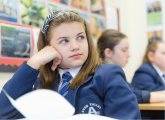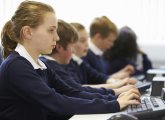Dr Joanna Rhodes has some inspiring suggestions for activities based around nanoscience…
TODAY YOU WILL…
LEARN ABOUT DIFFERENT SIZES OF OBJECTS AND THE TOOLS WE USE TO INVESTIGATE AND MANIPULATE THEM
DEVELOP YOUR UNDERSTANDING OF PARTICLES
I asked my pupils if they thought it possible that in their lifetime we could have machines so tiny we could inject them into our blood where they could clear blocked arteries, kill tumours or perform operations with no need for cutting at all. We explored how little something would need to be to travel inside your body, and what size the components inside such a miniature machine would have to be – and then I asked what they thought ‘small’ means. A nanometer is one billionth of a meter (10-9 meters). That’s a really miniscule measurement, but it’s hard to imagine just how small it is. A nanometer isn’t just tiny in the way that a grain of sand or a speck of dust is – it’s thousands of times smaller than that. In this lesson, students really get a chance to appreciate what that means, and understand how even microscopic particles can have powerful properties. Cross-curricular links are made between science, mathematics and history, and there’s also an interesting insight into current and future medicine; enjoy!
STARTER ACTIVITY
Explore the idea that we can use microscopes to look at objects that are too small to see with the naked eye. A range of high quality and low cost options are available, including hand held video microscopes and ones that connect directly to a whiteboard [Additional Resource 1]. Students can investigate biological specimens, but also encourage them to look at scratches on the surface of coins [AR 2], salt or sugar crystals, and other common or everyday objects in the lab such as paper or clothing [AR 3], which are less often visualised in close up. Contrast with how other things that look tiny to us and are far away can be investigated using a telescope. Telescopes don’t need to come out at night; you can investigate a distant object such as a house or a car in the school car park. You could also use binoculars to view objects within the classroom. Ask pupils how they can tell the size of the object they are looking at and to record some of the sizes of objects large and small they have viewed by using the scale of the instruments they have used
MAIN ACTIVITIES
NANOSURGEONS
If medical work is to be carried out at the molecular level by machines then it is fun to imagine how small the machines would need to be. Divide students into groups and ask them to build Lego models while wearing oven mitts on their hands. Then ask them to discuss the relationship between the size of the objects being manipulated and the size of the tools needed to manipulate them [AR 5]. Colloidal silver nanoparticles are an antifungal agent used in bandages. Unlike silver ion solutions, colloidal silver is toxic to microbes, without harming humans. Investigate this further by preparing some inoculated agar plates and using small squares of a silver plasters or dressing and comparing this with the action of silver nitrate on circles of blotting paper and other antimicrobials such as disinfectant and tea tree oil. Further experiments, including how to synthesise colloidal silver, and use it to measure the inhibition of yeast [AR 6] could be used to enthuse and extend gifted and talented students.
WATERPROOFING SMARTPHONES
An experiment using superhydrophobic surfaces can vividly demonstrate how the incorporation of nanoscale texture at a material’s surface can lead to dramatic changes in the properties of the material. Nanoscientists often find inspiration in nature and this experiment models the way that pond insects use hydrophobic feet to skate on water. Purchase a coating spray for outdoor garments from a camping shop and allow students to use it to coat different fabrics. Once dry they will be able to observe how it becomes difficult or impossible to get water to soak into the material. They can also see the shape formed by the surface tension of the water on a hydrophobic surface, which stands up in a rounded way instead of forming a meniscus as with a beaker or measuring cylinder. Students could even synthesise their own hydrophobic materials using a guide produced by the High School Nanoscience Program [AR 7]. If sand is sprayed with outdoor garment spray it can be immersed underwater in a beaker and removed dry. This technology when employed at the nanoscale level can render entire electronic devices waterproof including smartphones and mp3 players. Dramatic video of a phone being immersed underwater had my class captivated [AR 8]. The technology was only unveiled in early February of this year.
STRETCH THEM FURTHER
STUDENTS CAN INVESTIGATE THE CONCEPT OF NANOSIZE FURTHER WITH A COUPLE OF INTERESTING EXPERIMENTS STARTING WITH MAKING DILUTIONS OF 10 DROPS OF FOOD COLOURING [AR 10]. IN THESE EXPERIMENTS STUDENTS MAKE CONSECUTIVE DILUTIONS OF 50% UNTIL THE COLOUR FROM THE FOOD COLOURING IS LOST COMPLETELY. STUDENTS CAN USE THE NUMBER OF TIMES THEY HAVE DILUTED THE SOLUTION TO WORK OUT HOW MANY TIMES MORE DILUTE THE FINAL SOLUTION IS WHEN COMPARED TO THE STARTING SOLUTION. WHILE THE EXPERIMENTAL WORK IS QUITE SIMPLE, THE MATHEMATICAL PROCESSING IS MUCH MORE CHALLENGING AND CAN LEAD TO INTERESTING DISCUSSION BETWEEN STUDENTS IN HIGH ABILITY GROUPS.
Summary
Nanoscience is considered to be a new technology and is at the forefront of modern innovation. However students will find it interesting to discover that gold nanoparticles were being made and used in medieval stained glass windows. The artisans creating the windows trapped gold nanoparticles in the ‘glass matrix’ in order to generate the ruby red colour in the windows. They also trapped silver nanoparticles, which gave it a deep yellow colour. This example of colour change is testimony to the dramatic change in material properties at the nanoscale. Gold nanoparticles can be made using a relatively straightforward technique in the classroom laboratory where gold (III) is reduced to gold using sodium citrate [AR 9]. The bright red colour can be linked to Home Learning 2, the Lycurgus Cup.
HOME LEARNING
- Gifted and talented pupils may be able to attempt an interesting calculation using a sugar cube. Explain to students that one sugar molecule is about 1 nanometre in size and that a nanometer is 1 billionth of a meter. Ask students to calculate how many molecules they think could fit along one edge of the sugar cube. When they calculate such a large figure it is a good illustration of how small molecules must be [AR 11].
- Ask students to investigate the Lycurgus Cup [AR 12]. This ornate Roman Cup displayed at the British Museum was made in the fourth century AD and the colours of the cup can change. When it is looked at in reflected light or daylight, it appears green. However, when light is shone into the cup and transmitted through the glass, it changes colour to red. What gives it these unusual optical properties is due to the glass containing tiny amounts of colloidal gold and silver. Students can present their findings to each other through presentation, a historical ‘newspaper’ report of the amazing vessel or a short piece of drama based on the presentation of the cup to Roman Emperor Constantine. It could also form the basis of an interesting science school trip if the British Museum is accessible.
ABOUT THE EXPERT
Dr Joanna L. Rhodes M.Chem, D.Phil, MRSC is a teacher of science at Shelley College, Huddersfield.










